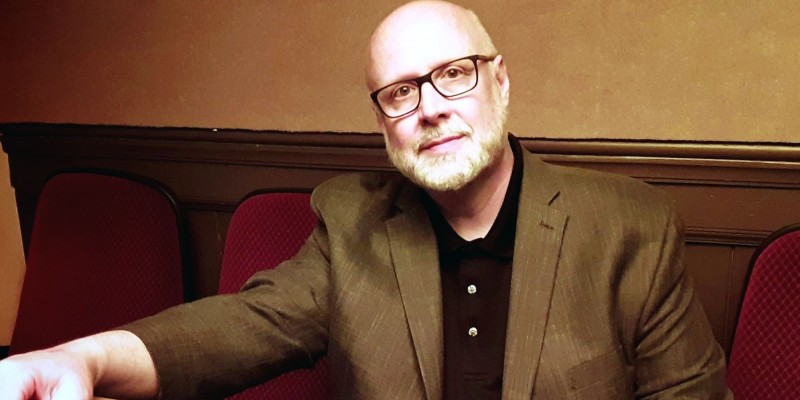I first met Steven Bentz in 1999 when I was teaching graphic design at Parkland College and he was a student in one of my classes. Little did I know then that we would some day share a love affair for a grand old lady over one hundred years old. Her name is Virginia, as in the Virginia Theatre where Bentz is now the director.
We reconnected in 2017 when the Virginia Theatre screened Dunkirk. You may recall that when Christopher Nolan’s World War I epic premiered, it first opened nationwide on IMAX screens. This was just a few years after all first-run theaters in the U.S. converted to digital. But Nolan shot Dunkirk on film, and he insisted that his epic be also released on actual celluloid film.
There were only about one hundred 70mm prints struck for Dunkirk and under Bentz’s direction (and some behind-the-scenes maneuvering) our own Virginia Theatre was lucky enough to be granted one of those prints to screen.
I immediately emailed Bentz to ask a favor. All my life, I’ve made it a point to catch as many 70mm screenings as possible, but I’ve never actually touched a real 70mm print. I wanted to visit the projection booth to actually look at the images chemically imprinted on clear celluloid film. After the screening, we climbed all the way to the top of the balcony and I was allowed to touch the actual film we just watched. That was a night to remember.
It was not the first time I’d been in the Virginia’s Theatre’s projection booth. After high school, my first full-time job was at the Virginia Theatre. I was the assistant manager, and part of my job was running those 35mm projectors up there. Those big ol’ projectors didn’t intimidate me because, well, I was that A/V geek in high school who was always helping the teacher thread those 16mm educational films in the classroom (those readers who are old enough know exactly what I’m talking about).
If you’re a townie and you saw the first Star Wars at the Virginia, I probably projected it for you. I didn’t know it back then, but those projectors could also run 70mm film. Not many cities can claim to have a fully-operational single-screen movie palace that can still project movies on actual film stock. Even more rare are those original Todd-AO projectors in the booth which made 70mm screenings of films like Dunkirk possible.
I was reminded again of just how special the Virginia Theatre was when I attended a recent screening of The Artist in that beautiful space. I thought it was time to reconnect with Bentz again to chat about movies, the history of this incredible space, and what it’s like being the steward of this gem right here in downtown Champaign. Our conversation took place in the last row of the Virginia’s main floor auditorium, a place Bentz called his “second office.”
Smile Politely: You’re the “director” of the Virginia Theatre. What does that mean?
Steven Bentz: It’s kind of a combination of three roles. I’m the manager of the space, so it’s an administrative role which includes hiring and supervising the staff. I’m also the creative director of the Virginia, so I’m overseeing the programming of the room. This means working on the self-presented series of live shows and films that we put together every year and then also working with our rental clients — a lot of diverse stuff happens in this room. And then there’s the “department head” aspect of the position: the theater is owned and operated by the Champaign Park District, so I represent the Virginia within the Park District family.
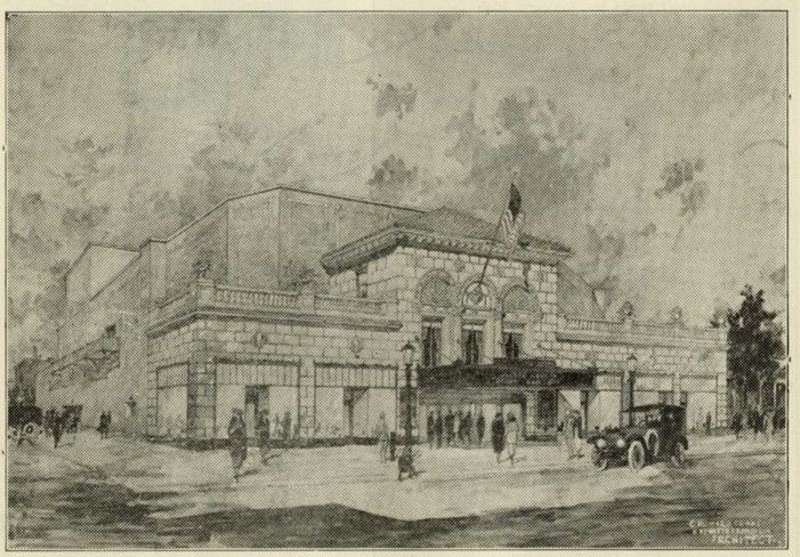
An architect’s drawing of the proposed Virginia Theatre circa 1920. Image from the Champaign County History Musuem.
SP: How long have you had this role?
Bentz: It’s been 11 years. But the theater has been here for over 100 years. In fact we just had our 100th anniversary on December 28, 2021.
SP: Since Champaign Park District acquired this theater, how much money has been pumped into it?
Bentz: We invested about $10 million in restoring the building since then, but that was done in phases. In the first few years it was just about making sure it didn’t burn down — so we addressed the electrical. When we first came in, I was told the emergency exits down at the end of the main lobby were nailed shut. Well, that’s not good, so we addressed items like that immediately. We had big issues with water in the basement — the dressing room level would routinely flood to like thigh height. There are a lot of stories from those early years!
SP: $10 million is a lot of money.
Bentz: It sure is, and we’re incredibly fortunate that the community valued the Virginia so highly. Champaign-Urbana just wasn’t going to let it sit unused or be torn down. When I first started here, it was just before the beginning of the third phase of restoration. This was the auditorium phase that cost $5.5 million and ran from June of 2012 to April of 2013. There were a lot of jackhammers in the building! We had to do abatements of lead and asbestos. It was a complete refurbishment of the auditorium and stage spaces, taking them back to their 1921 splendor. You can see a wonderful 5-minute video on Youtube about the restoration created by the local filmmakers at Shatterglass Studios.

Screenshot from Shatterglass Studios.
SP: So now the restoration is finished.
Bentz: In effect, yes. And, as it turned out, it’s got a lot more bling to it than we ever expected because all the original design was so covered up with layers and layers of paint. I used to say that the colors that were painted over the original plaster were kind of Howard Johnson colors. It was kind of pale orange and sickly teal, but now the room is what it looked like back in 1921. Which was the whole idea all along.
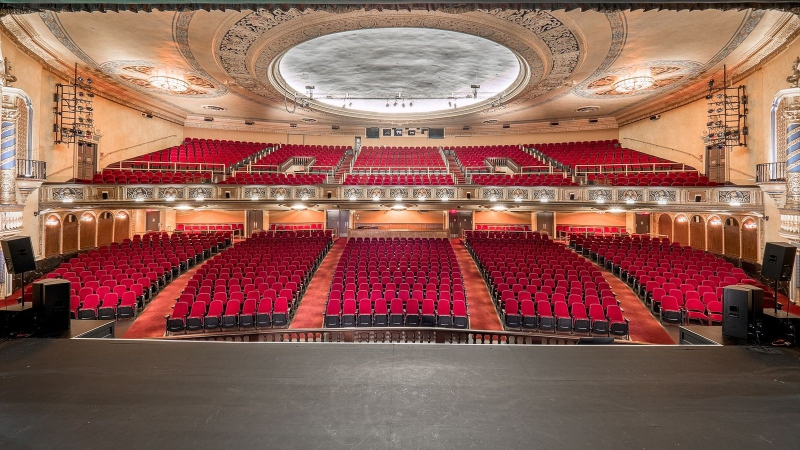
Photo by 3D Tour Gallery Photography.
SP: Over the years, I’m sure you’ve developed a special relationship with the physical building itself.
Bentz: I do feel kind of connected at the hip to this thing ’cause I’ve spent a lot of hours in the building over the past 11 years.
SP: My connection to this space has always been the movies. I have fond memories of hosting private movie parties here in the 1970s – since I had the keys.
Bentz: You can almost tell the story of the movies through the history of this space. In 1921, when the building first opened, one of the first movies we showed was Buster Keaton’s The Boat which is one of my favorite silent movies.
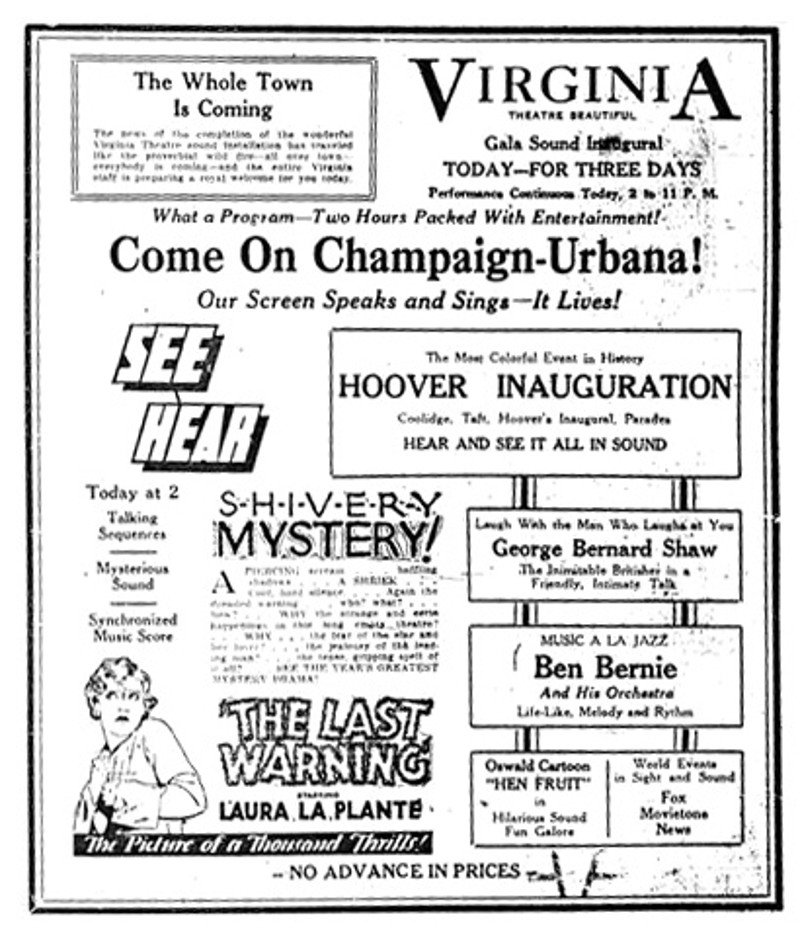
Image from Champaign County History Museum.
SP: So by 1929 you’ve got the introduction of talkies, then what?
Bentz: Then there’s a sea of change in the 1940s and 50s with the introduction of things like CinemaScope and 3D. Then came other widescreen formats like 70mm gaining popularity in the 60s. And then you’ve got digital. I mean we’ve basically gone through every one of those transitions right here in this room.
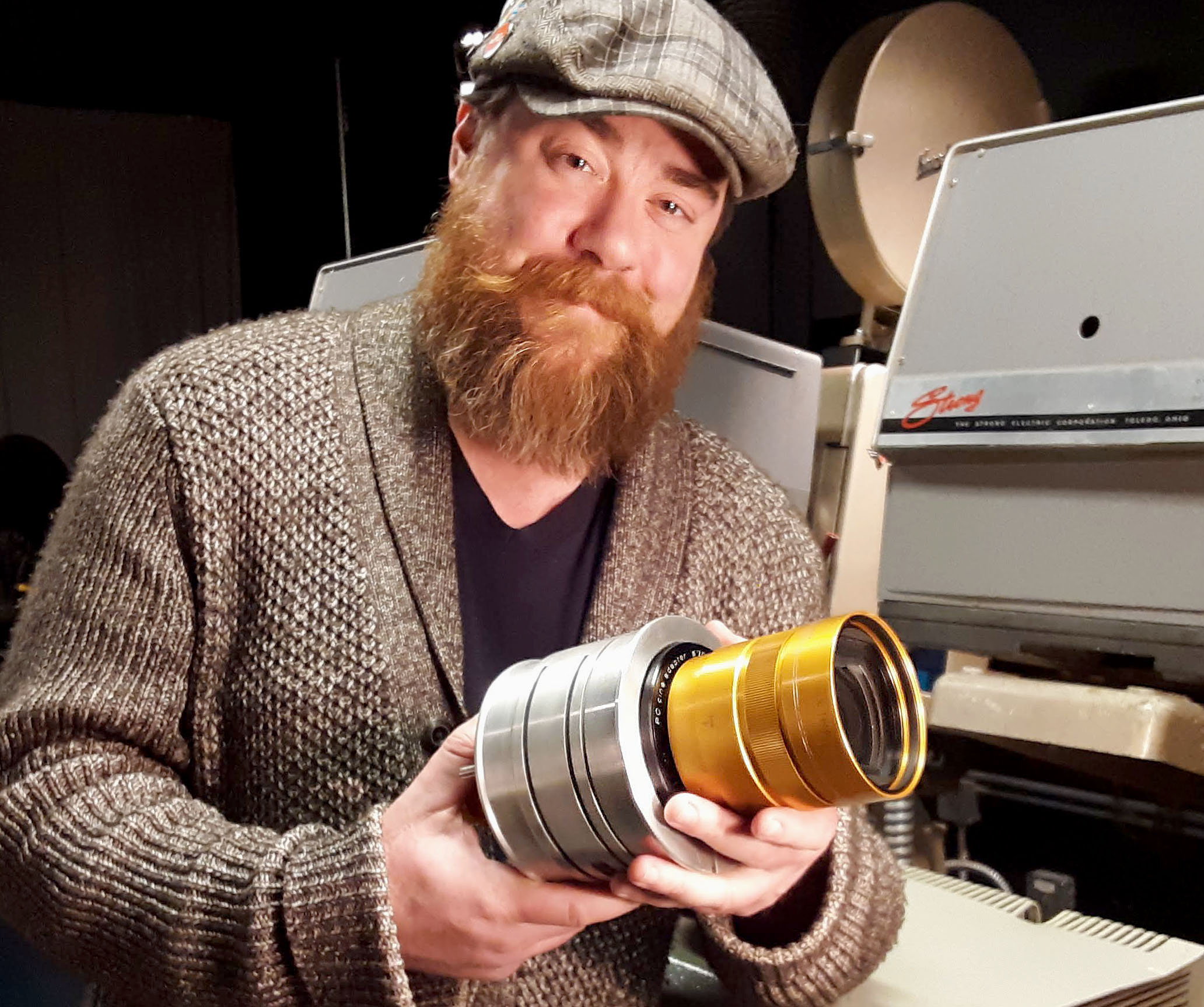
Virginia Theatre’s technical director Stephen White holding a CinemaScope lens which stretches the image horizontally to twice its original width. Photo by Paul Young.
SP: And now we’ve got streaming.
Bentz: There’s certainly nothing wrong with streaming, but I also think another big transition we’re seeing in home viewing is just about scale — wider screens and bigger speakers. So, what’s the reason for going out to a movie theater? I think that with a space like the Virginia, you can still have the true spectacle part of the experience because we’ve got this massive 52-foot image that’s covering up your entire field of vision, and you also get to be part of a community of people watching the film. People see old friends and teachers and colleagues when they attend a screening at the Virginia, they reconnect with neighbors, they even meet their future spouses here!
The other unique thing we have going at the Virginia is our curated film programs — the careful selection of titles and themes for our repertory film series.
SP: There’s now a nostalgic 35mm revival movement and the Virginia Theatre is one of the few places in the states where it’s still possible to screen actual motion picture film on celluloid.
Bentz: Not only 35mm, but 70mm which is even rarer. These days everyone wants a 4K TV monitor, but 70mm is the equivalent of 8K where the image is so sharp and the resolution is so high that you can really only appreciate the beauty of the image on a giant screen like the community has here at the Virginia.
SP: And it was Roger Ebert that helped jump-start the projection booth rehabilitation here at the Virginia.
Bentz: Yes, when Kerasotes sold the building, they left one single 35mm projector in the booth but disabled it to prevent anyone from running movies here and competing with them in this market. So, the News-Gazette stepped in and contributed $50,000 to rehabilitate the projection booth. There was also considerable support from James Bond’s company Full Aperture Systems. The surround sound system, which is a system of 32 speakers spaced all over the auditorium, came to us from them. You were here for Dunkirk, so you probably remember how during the battle scenes you felt those explosions in your bones. And you just fall into the movie in a way that you can’t at home.
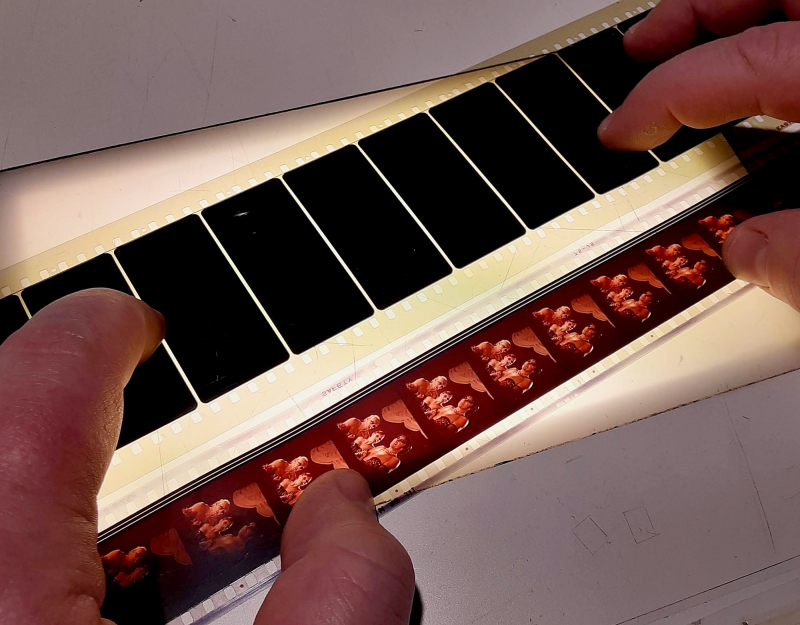
A strip of 70mm film next to 35mm film. Photo by Paul Young.
SP: Obviously you’ve got a great staff to help you out.
Bentz: Yeah, I love that they’re all creatives on this team. Our technical manager Steven White is an amazing vocalist and has been in a number of different bands. And Mitch Marlow, our PR guy, is also in a number of different groups. He’s a really good guitarist and bass player. Our former box office manager, Jenny Carpenter, is a vocalist and she’s been in a bunch of different groups as well. And then there’s Chelsea Norton, she’s the Park District Marketing Director and is also a bass player.
SP: Are you a townie, too?
Bentz: Yeah, I’m a Carle baby. I feel very connected to this community and especially to this space. It’s been the opportunity of a lifetime.
SP: Yes, I’m kinda jealous. It’s a very special place and I still get goosebumps every time I walk into this room.
Bentz: Me too! We often get asked about ghosts, and I’m sorry to disappoint on that score: we’ve never seen a thing, honest! But, when you’re standing in that auditorium, especially when it’s empty, there’s a weight to it. This space has seen 100 years of the people of east central Illinois coming and going, to weddings and dance recitals, to big concerts and community fundraisers, to movies and community theater. And through those years, people like you also came here to work or volunteer. Stand still inside the Virginia for long enough and you can’t help but feel the presence of all that history, of all those moments of celebration and people coming together to enjoy what a unique theater like the Virginia can offer.
______
When he is not watching one film a day, Paul Young likes to travel the world seeking good things to eat. So far, he has eaten his way through 22 countries and he loves to share his culinary discoveries with cooking classes.








